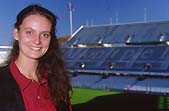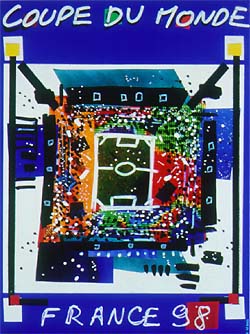|
|
|
|
|
Paris, 23 november 1997 |
THE ARTIST
|
|||||||||
|
" The Official Poster and the competition's winning team are the two things about FRANCE 98 which will live on in the collective memory ", says Michel Platini, Co-President of the French Organising Committee for the 1998 World Cup.
Alongside the Mascot and the Logo, the Official Poster is the third linchpin in the 1998 World Cup visual identity programme. As it was keen to include young people in the project, the French Organising Committee decided to assign Beaux Arts (Art school) students and local artists at the 10 host cities the job of dreaming up a poster. In the Spring of 1997, according to a schedule of conditions set down by the French Organising Committee, the cities of Bordeaux, Lens, Lyon, Marseille, Montpellier, Nantes, Paris, Saint-Denis, Saint-Etienne and Toulouse launched the contest among Ecole de Dessin (design school) and Beaux Arts students, as well as local artists and independent organisations. On 31 October, a jury of 8 representing the French Organising Committee, the French Football Federation, the National Football League and FIFA's marketing agency, selected the entry by Nathalie LE GALL, a Beaux Arts student from the Montpellier region, as the winner. "The World Cup has to be a celebration! I wanted to portray it as an event that fizzes with excitement by using brilliant colours evoking France and the whole world," says the young artist. Aside from the Official FRANCE 98 Poster, the programme of official promotional support for the 16th Football World Cup also includes a series of exclusive posters for each Host City. Each poster is also the work of a young artist from the city represented. |
|
Nathalie LE GALL was born in Paris' 14th arrondissement on 31 December 1970. The youngest of four children, she grew up in the city suburbs.
From the age of 11, her parents allowed her to visit artists' studios to watch the painters and designers at work. She left secondary school at sixteen to study at a specialised school of design for two years, and it was at this time that she decided that design was the career she wanted. As well as carrying out personal research at workshops, she did various courses in design, illustration, paper cut-outs and mosaic work. She also landed work in such diverse areas as promotional scarves, record sleeves, and publicity posters and illustrations. She is currently in her second year of study at the Beaux-Arts in Montpellier where she is completing her education. Nathalie is not especially interested in football; her links with the "sporting" world amount to seven years of classical dance. |
||||||||
|
Interview |
||||||||||
|
The French Organising Committee launched a competition in the Beaux Arts colleges throughout the 10 host cities for the design of the official FRANCE 98 poster. The winning entry was by Nathalie Le Gall, aged 26 and a student at Montpellier.
I found the idea very appealing straight away, probably because football is a closed book to me. Of course, I'd seen the odd match on television, but I didn't know much about the game, apart from what I may have picked up from my father and brothers, who are all great fans. What really inspired me was the idea of finding an idea, a universal message which could be understood the world over.
I tried several things out. At the start I used players in my design, but I wasn't at ease with that approach. I had to find a wider vision of the whole event. Then I tried something with planets, but I abandoned that idea as well in favour of something involving people. A planet's all very well, but you don't get much sense of the countries... Then I thought, well, the World Cup will have to use highly sophisticated telecommunications technology to relay pictures from the competition all round the world. In the communication era we all live in today, the role of satellites is tremendously important, so I wanted somehow to convey the idea of the speed of transmission through a bird's eye view of a stadium. This also allowed me to highlight the building and renovation work being carried out on all the FRANCE 98 stadiums, and to create a kind of synthesis of all these elements of modern life.
I created a kind of living pictogram, a highly coloured image that was easy to understand. On the canvas you can see a number of different techniques: collage using cut-out paper, solid colours using gouache and reproductions of images taken from magnetic resonance pictures. It meant very detailed work on the collage. The stands, in fact, are represented by an infra red picture of a human body, as it's photographed with the process used in medical work. I cut that out of a magazine. It forms a whole mixture of colours and blobs representing the crowd. It's rather fun to represent the public in a football stadium using images from the human body!
A World Cup is a party! It's really got to "move" in every sense! It's an event that bubbles! These colours give that festive feel, that brilliance that takes your breath away. |
||||||||||

